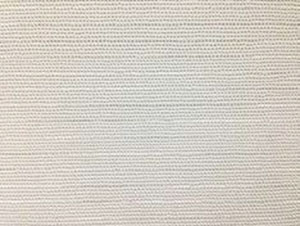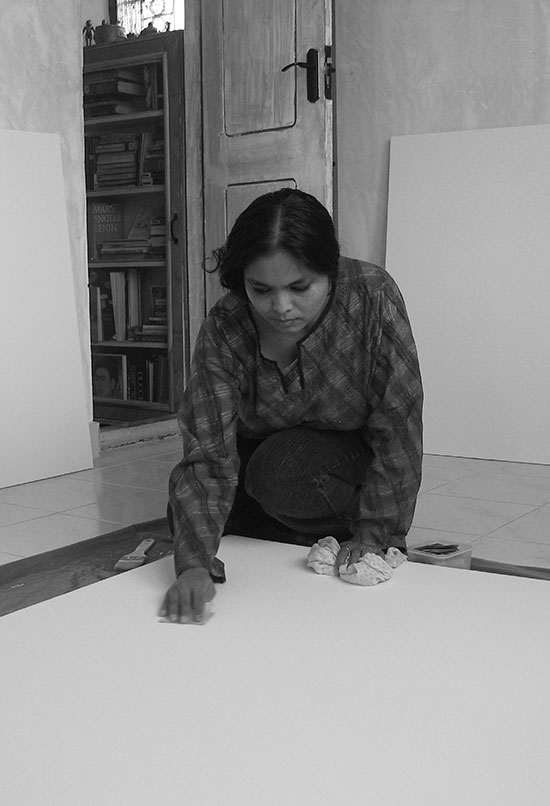Like night and day, two absorbing exhibitions at two Chelsea locations of the Pace Gallery a block apart shuttle between the “dark palette” paintings of Mark Rothko and the gleaming white monochromes of Prabhavathi Meppayil.
Taken in tandem, they bridge the emotional and cultural limits of abstraction, from the fiery Greek and Semitic roots of tragic catharsis as tapped by one of the giants of Abstract Expressionism to the cool glint of Minimalism in the hands of a contemporary Indian artist making her North American debut.
The opening gambit in the wall text for the museum-quality Rothko show is a seven-part, tongue-in-cheek “recipe” for a work of art that Rothko wrote himself. It is possible to identify different paintings in the exhibition to prove each of the bullet point “ingredients,” starting with the opener: “There must be a clear preoccupation with death—intimations of mortality … Tragic art, romantic art, etc., deals with the knowledge of death.”
While Arne Glimcher and the artist’s son Christopher Rothko expend considerable energy in the catalogue to dispel the direct correlation between the “dark palette” that characterized the work in the artist’s last 13 years and his suicide, the temptation to succumb to the fatalism of these paintings is difficult to avoid. Among many that fit the tragic bill, the elegiac weight of the inky bars in Black in Deep Red (1957) is a wordless gloss on Rothko’s well-known reading of the ancient Greek tragedian Aeschylus.
.

"Black in Deep Red" by Mark Rothko, 1957. Oil on canvas, 69 3/8 x 53 3/4 inches. © Kate Rothko Prizel & Christopher Rothko / Artists Rights Society (ARS), New York.
.
The second item on his list is “sensuality,” and the “lustful relationship to things that exist.” I think of this as the subtext of Untitled (1968), a relatively small work painted in acrylic on paper mounted on board, with its flickering flames of bright cardinal red licking at the edges of the bottom beam of black. This painting is hung in a room that is better characterized by the third and fifth ingredients, “tension” and “wit.” In this room, the compositions pair cool blue edges with the warmer burgundies and browns of the palette that dominate most of the exhibition, as in Untitled (1969).
.

"Untitled" by Mark Rothko, 1969. Acrylic on paper, 51 5/8 x 41 inches. Collection of Christopher Rothko © 1998 Kate Rothko Prizel & Christopher Rothko / Artists Rights Society (ARS), New York.
.
I identified the fourth ingredient on the list, “irony … the self-effacement and examination by which a man for an instant can go on to something else,” in Mural, Section 6 (Untitled) [Seagram Mural]. The title of this piece is a reflection of the ambiguity surrounding the infamous commission, which Rothko declined to complete, returning the cash advance he had received from the Seagram company to create the murals for the Four Seasons restaurant in the company’s new building on Park Avenue. Playwright John Logan speculated on the reasons for the breach of contract in his gripping play, “RED.”
The huge summit of the show, Mural, Section 6 (Untitled) [Seagram Mural] marches in a stately row of portals along one unforgettable wall in the Pace exhibit.
The seventh and final ingredient on Rothko’s list: “Hope. 10% to make the tragic concept more endurable.” Rounding back to the tragic first element, Rothko banks on redemption. An absolute highlight of the exhibition is the towering vertical Untitled (Dark Gray on Maroon), on loan from the National Gallery in Washington, D.C. More than eleven feet high, it towers over the viewer whose gaze is hauled upward by its scale and the steady pace of its horizontal bars. Made in 1963, it reminded me of a cryptic remark the artist made to Dore Ashton at the time, when he was reading the theological writings of Origen, that the thoughts in the text “went toward ladders.”
Although a major undertaking, the presentation is not perfect: the lighting in all the rooms was too bright. The artist himself was adamant about the need for low levels of illumination as the context for viewing the “dark palette” paintings. When Ashton visited him at the former carriage house at 157 East 69th street where he worked, his studio was plunged in shadow.
The problem with too much light, such as the cool and even lighting many museums use in the Abstract Expressionist galleries—where Rothko and Newman are hung alongside Pollock and de Kooning—is that it blanches rather than activates the reflective candlepower of the colors. It also seems to reduce the paintings to the status of merchandise in a sterile clothing emporium like H&M or Uniqlo. The only advantage I could discern was a chance to closely examine the edges of the canvases, which reveal underpainting and priming more clinically than in dimmer light.
Rothko’s East End connections include a particularly productive summer in Amagansett at a cottage overlooking Gardiner’s Bay, where he listened to Schubert’s “Trout Quintet” while pondering his approach to the commission from John and Dominique de Menil to create an installation for an octagonal chapel in Houston, Texas, which many consider the ultimate structure to house his work.
After his suicide in 1970, his friend Theodoros Stamos offered one of the family plots in a cemetery in East Marion on Long Island’s North Fork. The artist’s daughter Kate, who loaned many of the paintings to Pace for the show, successfully sued in a Riverhead court to move his remains to Westchester but never did take them.
By comparison with the full shelf of biographical and critical scholarship on Rothko, there is precious little information available about Prabhavathi Meppayil, who was born in 1965 in Bangalore. Her snowy white monochromes pulse with optical excitement, a brilliant contrast to the tenebrous Rothko “Dark Palette” paintings.
.

"n/eighty five" by Prabhavathi Meppayil, 2016. Drawing with thinnam on gesso panel, 24 x 24 inches. Courtesy of Pace Gallery.
.

"n/eighty three" by Prabhavathi Meppayil, 2016. Drawing with thinnam on gesso panel, 24 x 24 x 1 1/2 inches. Courtesy of Pace Gallery.
.
Bathed in appropriately intense, cool light, these paintings beg the viewer to linger. From a certain angle, glinting reflections on the powdery gesso dance like sun on snow, and a pattern of blurred “ghost” images of rectangles start to appear the way the white “stars” flicker at the intersections of black lines in a Mondrian. This is the artist’s North American debut, following a large-scale exhibition in 2014 at Pace London and her installation, “The Encyclopedic Palace,” at the Venice Biennale the year before.
The most salient biographical tidbit I found reveals that she comes from a family of goldsmiths whose craft includes imprinting bangles with a tool called the thinnam. The inner galleries of the show are filled with paintings made by arranging tightly controlled rows, often from top to bottom of the work, of tiny ornamental impressions carved in a range of geometric forms using a thinnam. My favorite is a small square surrounding a central dot; others include a circular dimple that mimics those found on the surface of golf ball.
.

Detail: "n/eighty four" by Prabhavathi Meppayil, 2016. Drawing with Thinnam on gesso panel, 48 x 47 15/16 x 1 1/12 inches. Photograph by Manoj Sudhakaran. © Prabhavathi Meppayil, Courtesy Pace Gallery.
.
The array of six of these thinnam paintings, gathered under the title n/eighty-two on a central wall deep in the recesses of the gallery, had the effect of an altar. The checklist refers to the work as a “drawing” and it has that kind of lightness and immediacy. A subdued photograph of the artist in her dusty studio shows her sanding down the gesso. In the background is a bookshelf with a Frida Kahlo cover turned to the camera.
.

Prabhavathi Meppayil in her studio in Bangalore, India. © Prabhavathi Meppayil, Courtesy Pace Gallery. Photo: Akshay M.
.
The subtle gesso slabs into which Meppayil has pressed copper or gold wires—strung across the works like the staves of a musical score—are the chromatic highlight of the show. A suite of 16, titled n/ninety three, slips as steadily as a river across one terrific wall, the copper line dipping below the surface and rising with mesmerizing unexpectedness. It starts straight and firm from the left edge of one panel, then suddenly rises in a little curve, like a fleeting blip of life on a heart monitor.
While the catalogue naturally invokes Minimalists from Sol LeWitt to Agnes Martin and Robert Ryman, I might add the name Mark Milloff to that list of Western masters of white on white. Meppayil works in Bangalore, and her work is also related to an older generation of Minimalists from India, including Nasreen Mohamedi (1937-1990), the subject of a large-scale exhibition at the Met Breuer, as well as Zarina Hashmi (born in 1937). Only a block from the Pace gallery where the somber shadows of the Rothko show are on view, Meppayil’s chalky white brightness is a world away.
________________________________
BASIC FACTS: “Mark Rothko: Dark Palette” is on view November 4, 2016 to January 7, 2017 at Pace Gallery, 510 West 25th Street, New York, NY 10001.
“Prabhavathi Meppayil” is on view October 28 to December 23, 2016 at Pace Gallery, 537 West 24th Street, New York, NY 10011. www.Pacegallery.com.
________________________________
Copyright 2016 Hamptons Art Hub LLC. All rights reserved.

just reading nobel winner eric kandel on rothko in his admirably interdisciplinary book:
Reductionism in Art and Brain Science: Bridging the Two Cultures
tremendous insight into the dark palette paintings